Much has been made of whether the new Mini Cooper really merits being described as such, because if you peel back the subtly updated bodywork, rip out the funky knitted dashboard and disconnect the massive circular touchscreen, you will be left with fundamentally the same chassis and body-in-white as those used by its predecessor, which went on sale way back in 2013.
While the electric Cooper is all-new, now built in China atop a platform co-engineered with Great Wall Motor, the latest version of the ICE hatch – still built in Oxford atop BMW’s front-driven FAAR platform – is more like a heavy facelift.
Unusually, despite their wildly different origins and underpinnings, the two cars look broadly identical, save for the EV’s flush-fitted door handles. That’s that cleared up, then.
Happily, the line-up of ICE models doesn’t need too much further explanation: you can still have three or five doors, a 1.5-litre turbo triple in the C or a 2.0-litre turbo four in the S or John Cooper Works, and things are made simpler still by the fact that diesel engines and manual gearboxes have fallen by the wayside across the board, for better or worse.
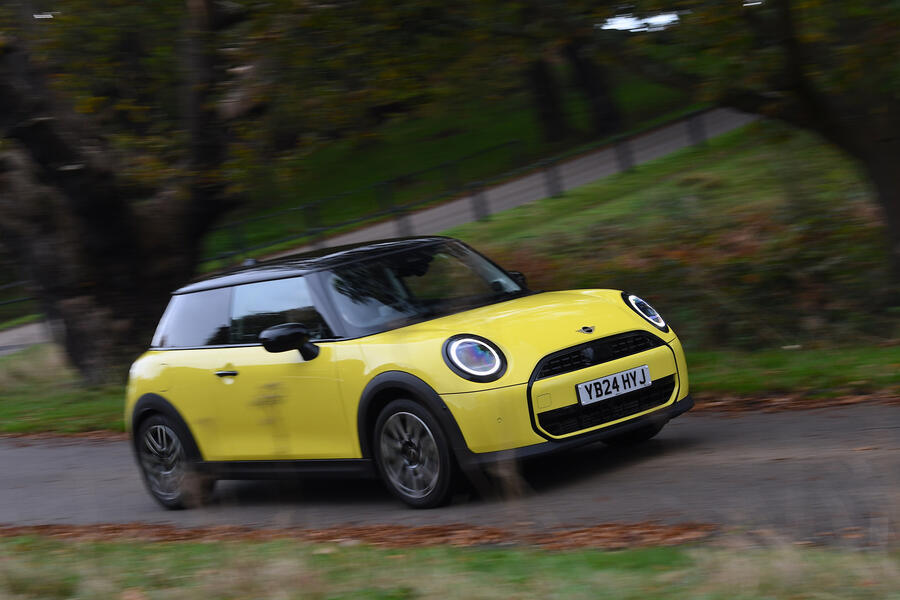
You needn’t even spend much time on the configurator any more. Pick from one of three trim packs (Sport, Classic or Exclusive), choose your paint and wheels, apply the ‘level’ of equipment you want (1, 2 or 3) and you’re there.
Our three-door C is an entry-level Classic but with the Level 2 pack, optional Sunnyside Yellow paint and jazzy 17in alloys, so it looks suitably high-spec without leaning towards the disingenuous connotations of sporting prowess implied by the dressed-up Sport.
It has adaptive LED headlights, keyless entry, heated front seats, a wireless phone charger and a panoramic sunroof – and I’ve yet to find it wanting for anything else. I’m glad, even, to go without the adaptive cruise control and in-car camera you get at Level 3.
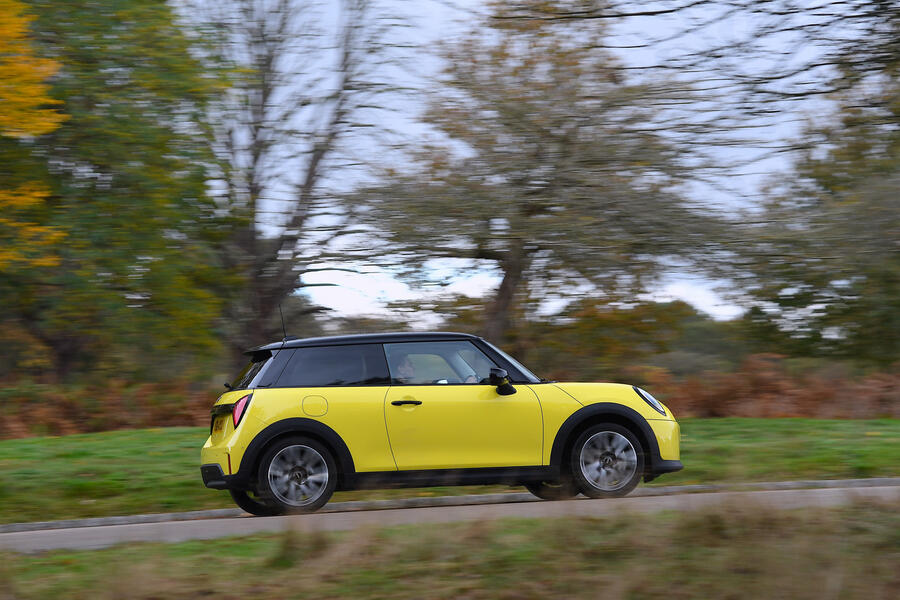
Coincidentally, the Cooper displaces another retro-styled, fashion-focused, bright-yellow small hatch from my parking space. Although I will miss my old Abarth 500e’s more overt sporting tendencies and lairier styling, I won’t miss its meagre 140-mile real-world range and 30-minute charging times.
By contrast, the Mini’s abstemious engine and chunky 44-litre fuel tank have essentially unshackled me, giving me the freedom to decide on a far-flung destination at short notice and tear out of the confines of the M25 with nary a consideration for how many stops I will need to make, or how many Netflix dramas I will need to download to keep me occupied at the Banbury Instavolt chargers.
I won’t miss them over the next few months, either, come to think of it. It’s underrated, that sense of liberation – especially as electrification and inflation conspire to make it ever more difficult to attain.
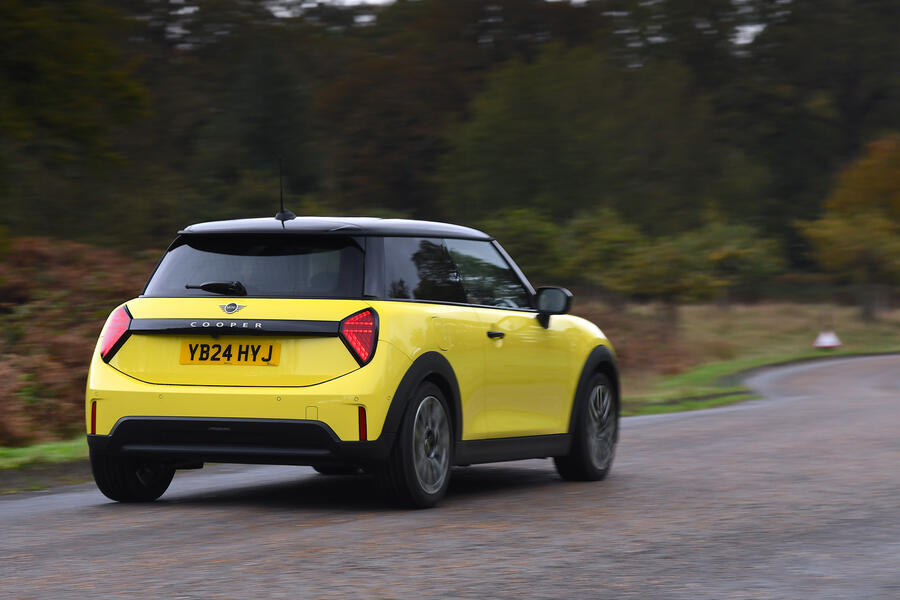
The Cooper is one of only a few petrol-powered superminis left on sale, with previous segment stalwarts having bitten the dust as their makers ramp up the focus on larger, more profitable (and usually electric) alternatives.
But even then, it’s hardly the people’s choice: with its starting price being £23,150, you would have to overlook some much more capacious crossovers – and an increasingly competitive field of EV alternatives – to plump for the Cooper in this day and age.
It’s hardly the de facto Ford Fiesta replacement that many are calling out for. In fact, it seems to occupy a relatively precarious position in today’s market. If people want small, they tend to also want cheap, and by the same token, if people want premium, they tend to go big.
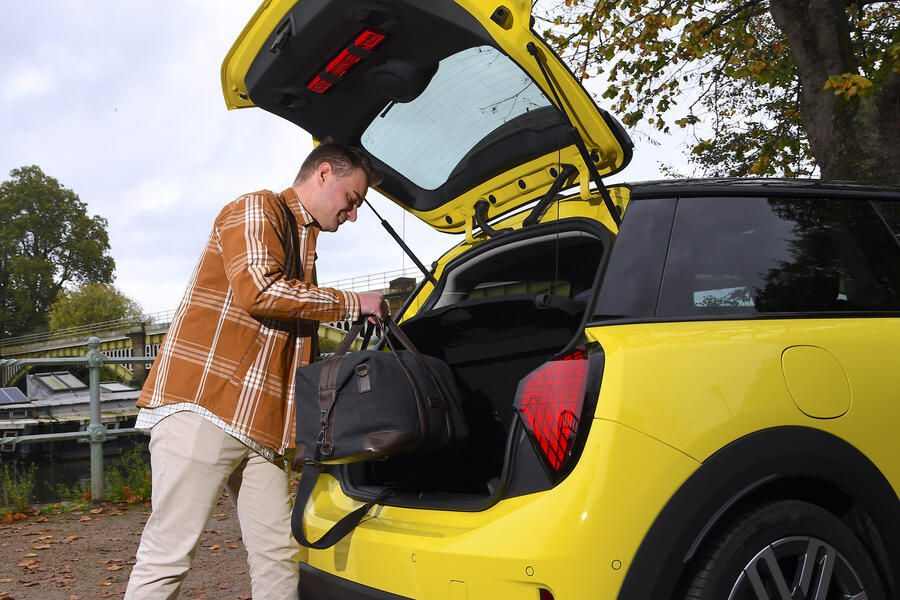
So today’s Cooper won’t have success handed to it on a plate. Especially when you consider the relative simplicity of its powertrain, the spatial limitations of its interior and some of the more controversial elements of its wide-reaching redesign (what was wrong with the traditional gauge cluster?).
But since its BMW-backed rebirth a quarter of a century ago (yep, seriously), the Mini name has carried rather more stylish and bourgeois connotations than did its 1959 namesake, and even more so in 2024. It’s probably a car you buy with your heart, rather than your head, so we must consider it in a different light to the Renault Clios and Vauxhall Corsas of this world.
Not to pre-empt the ‘goodbye’ report that I will be writing in a few months’ time, but I might as well reveal that I’ve already grown quite fond of YB24 HYJ.
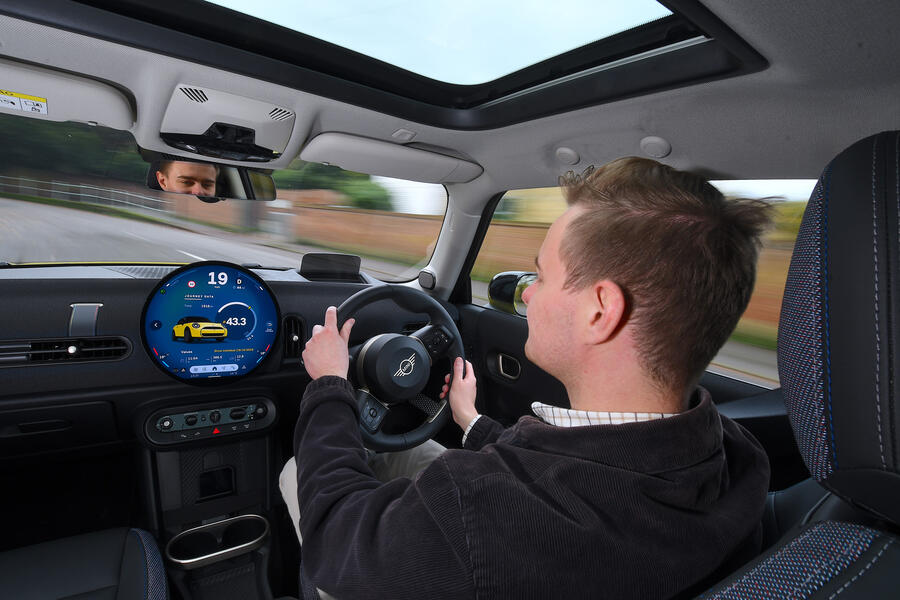
It’s agreeably peppy and easily manoeuvrable around my tight south London suburb, has as much kit as I could ever reasonably need on a daily basis and marries impressive frugality with big-car refinement on a long run.
It’s pretty fun to drive quickly, too, on the right bit of road, and the boot is just about big enough for a weekly shop. I love the way it looks, as well, and that Harman Kardon sound system punches above its weight.
Whoops! Haven’t left much to the imagination there, I suppose. But as a fanatical admirer of personable, relatively affordable small cars, there wasn’t really any question about whether I would generally get on with the Cooper.
What I need to know is if it still makes sense to be hurtling around town in something this small while burning petrol – and, probably more importantly, whether I needed to have spent nearly £30,000 for the privilege. Could a £15,000 Dacia Sandero (or, whisper it, a £15,000 Dacia Spring EV) do much the same job?
Update 2
Unlike many enthusiasts, I don’t harbour much resentment for SUVs: people buy a car to fulfil a role in their life, and if the criteria for that role include capaciousness, visibility and ease of access, then surely a tall hatchback makes the most sense.
But I do wonder if many prospective buyers could be talked down a size or two into something a little more manoeuvrable but barely any less useful in the real world.
Last Sunday, I came across a car parking space so tiny, so infinitesimally narrow and so tricky to access that my fellow shoppers weren’t even slowing down to consider it as a viable option.
The Ford Kuga next door was hanging over the line and the entry ramp was on the other side, so the angles were all off, too. There was a massive queue for spaces but nobody could bring themselves to have a crack at this intimidatingly inaccessible bay. It was no less than Sutton town centre’s take on the sword in the stone. But I knew that I could do it.
And so it was, with one eye on the rear-view camera display and a hand held up in casual apology to the driver behind me, that I deftly whipped my Mini Cooper rearwards into the gap with nary an inch to spare on all sides – without any correction to my chosen line and with no undue screaming from the parking sensors.
Hordes of dazzled onlookers encircled the car to applaud my victory, an announcement came over the Tannoy to congratulate me on my dexterity and at least four admirers ran over to offer me their favourite trolley tokens. There’s even talk of me becoming a knight of the realm.
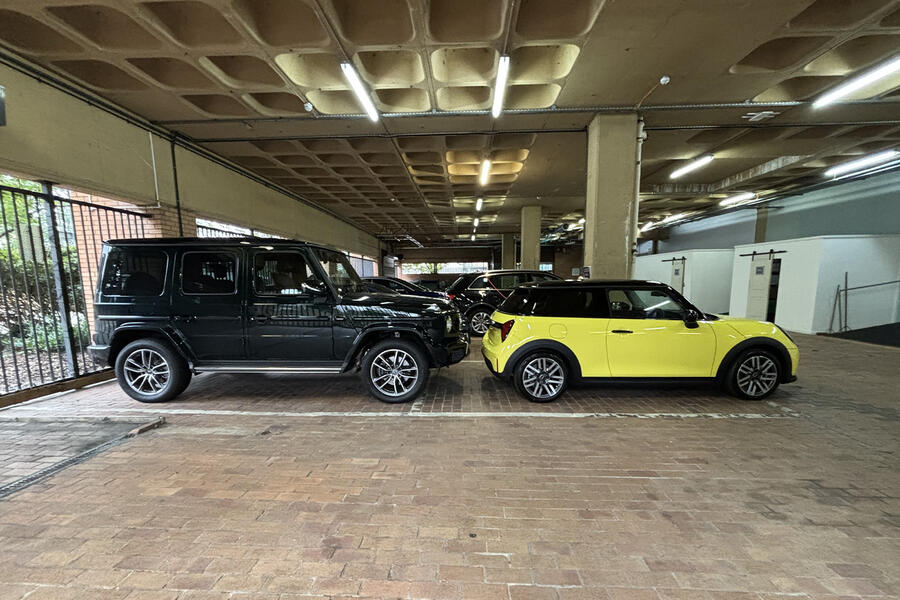
Well, not quite: I had to sheepishly straighten up afterwards, there was no chance of opening the boot and it was only my partner who expressed admiration – and only after I asked.
But the fact remains that I simply couldn’t have parked in anything bigger. While today’s Cooper is, of course, gigantic in comparison to the classic Mini, its dimensions have barely increased over the previous generation and it’s only very slightly bigger than the original BMW Mini of 2000. It remains a resolutely tiny car in the modern context.
Yet it just doesn’t feel especially tiny. The front seats are anything but cramped, the rears can take an average-sized adult or two for short hops and I’ve even yet to find the 210-litre boot wanting for capacity.
I went to the dump last week with all my garden waste, a couple of lengthy old shelves, a coffee machine and a small cupboard – standard fare for the casual tip tripper – and once I’d folded the rear seat flat, I might as well have had a little van at my disposal (725 litres).
Of course, about 12 minutes after I’d written the first draft of this report – which concluded with the line “I can’t honestly see why you’d need anything bigger for one-, two- or even three-up motoring” – my partner sent me a celebratory text to let me know she’d bought a cabinet on Facebook marketplace. “Don’t worry, it splits into two pieces!” she reassured me.
I didn’t even need to get the tape measure out to know I had no hope of getting either of those two pieces in the Mini, and so it was with a grim sense of defeat that I reluctantly opened the Zipcar app and paid £50 for three hours in a stinking, battered Volkswagen Transporter van.
Update 3
Heartbreak and elation in equal measure this week as my jolly Sunnyside Yellow Mini Cooper 3dr is snatched away and a rather more sinister Cooper S 5dr in Legend Grey is shuffled in to fill its space — and a little more besides.
The pang of sadness as YB24 HYJ departs is short-lived, because I’m technically moving up in the world: after a few months in the purest of modern Minis, the entry Cooper C, I’m swapping into the roomier and racier range-topper, all 201bhp, five doors and £34,500 of it. Punchy.
Of course, as well as having more kit and costing more money, this car can move more stuff around more quickly, so there’s reason to assume I will have a more engaging and more productive time behind the wheel.
But I will come back to that once I’ve had the chance to stretch its legs properly, because I don’t want to give the impression that I’m at all glad to be rid of the smaller, lower-powered Mini.
Far from it: these were some of the easiest and most cheerful miles I’ve spent in a new car. Part of that is contextual, of course — non-electrified superminis are now so critically endangered that any exposure to the breed is inevitably tinged with an air of the wistfully commemorative — but ultimately it’s just a really decent little car.
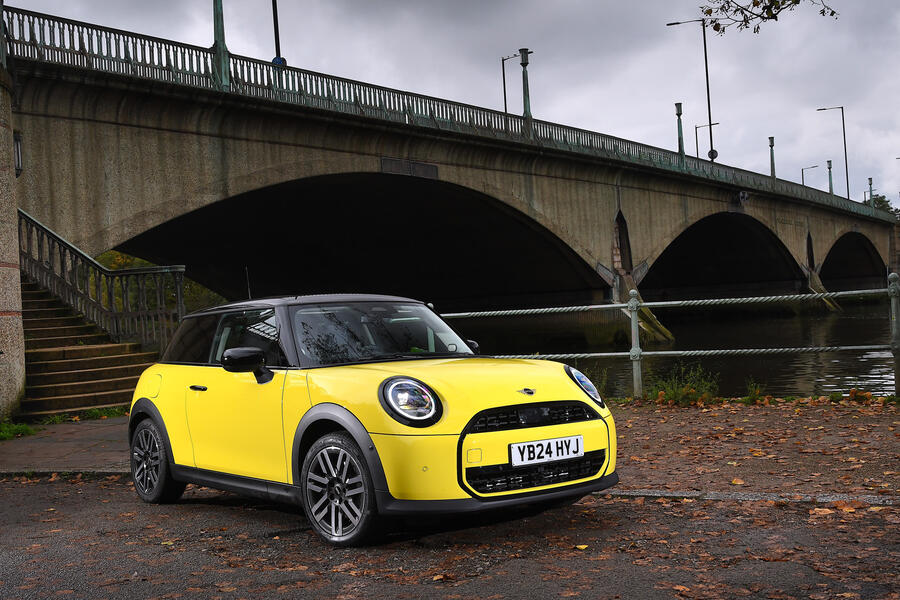
Press releases and Wikipedia entries refer to this model as the fourth-generation BMW Mini, but that’s a red herring because while the new China-built electric Cooper is a brand-new car on a brand-new platform, the UK-built ICE Cooper is more like a heavy facelift of the Mk3.
Indeed, the basic mechanicals and structure date back to that car’s launch in 2013 and the turbo triple under the bonnet is fundamentally unchanged since it was first used — fun fact alert — for the BMW i8 hybrid supercar.
But at no point over the past few months have I identified any area in which the ‘F66’ Cooper feels conspicuously old. Maybe the engine is a bit gruff on start-up. Sure, there are rougher edges to the low-speed ride. And things do get a bit noisy at a high-speed cruise. But broadly it feels every bit as slick and fresh as its box-fresh Aceman crossover and Countryman SUV siblings.
The minimalist but luxuriously appointed cabin, with its snazzy circular touchscreen (admittedly something of a bone of contention) is what most tangibly marks this out as a new-era Mini, and it always attracted admiring comments (usually accompanied by curious prods and strokes) from passengers — even if none of them could quite work out the point of that belt on the dashboard.
Mini has gone to great lengths to remove all unnecessary smockets and trimmings as part of a push to bolster its sustainability credentials and reduce manufacturing costs.
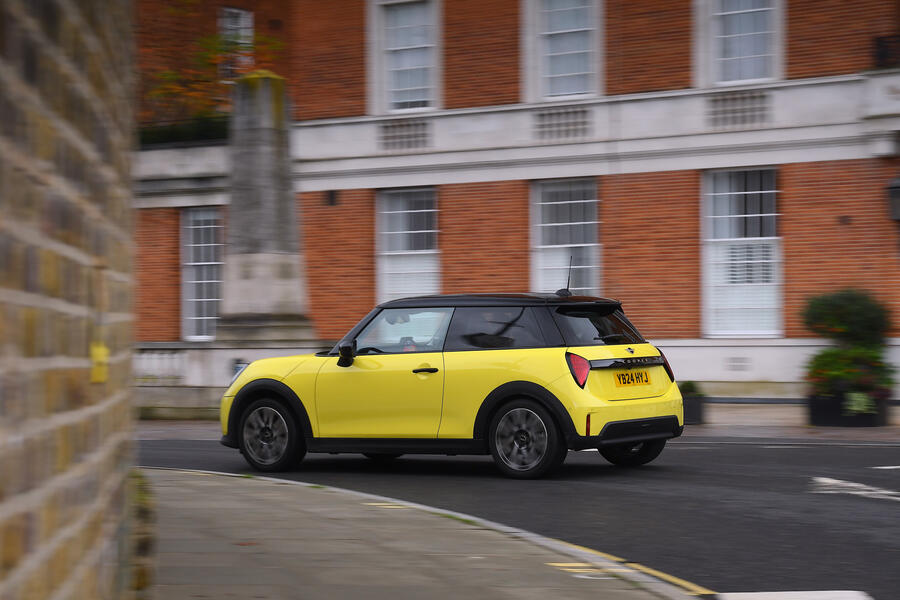
This might have cultivated a rather more austere environment had it been handled poorly, but as it is, we’re left with a bright, contemporary cabin that’s far more aspirational than that of any other supermini on the market – and a good few cars from loftier classes.
I will concede that it took me a while to get on with that touchscreen, and I will never forgive whoever approved the shoddy integration of the Apple CarPlay interface – quite literally a square peg in a round hole. But once I had learned the shortcuts for deactivating the hesitant start-stop function and irritating speed limit warning, it was all muscle memory.
The lack of a gearstick was a common gripe among those who tried the Mini over the past few months. With a chassis this taut, steering so engaging and a legacy so intrinsically linked to grassroots motorsport and accessible performance, surely, they argued, a Cooper should afford its driver the privilege of swapping ratios themselves.
That scene on the top of Lingotto would have been a drearier affair had Michael Caine’s Cooper S been equipped with an eight-speed DCT and the late, great Paddy Hopkirk might not have made such light work of the Monte Carlo Rally in 1964 if he hasn't been able to select the right cog for all those hairpins.
But I can't honestly say I lamented the omission of a manual shifter at any point during my stewardship. i think we should be grateful that there's still a petrol Mini on sale, to be honest. And besides, while the S does employ a Sport DCT gearbox with paddle shifters on the column, its hardly the most engaging and authentic feeling device.
But enough spoilers: I'm off to find out if the Cooper's prevailing strengths shine through in a more performance-focused context - and, more importantly, if its charm, honestly and everyman appeal survive a £12k price hike.
Mini Cooper C Classic specification
Prices: List price new £22,300 List price now £23,270 Price as tested £27,400
Options: Level 2 Pack £4000, Sunnyside Yellow paint £550, 17in Parallel Spoke alloy wheels £550
Fuel consumption and range: Claimed economy 47.1mpg Fuel tank 44 litres Test average 39.7mpg Test best 43.1mpg Test worst 36.5mpg Real-world range 384 miles
Tech highlights: 0-62mph 7.7sec Top speed 140mph Engine 3 cyls in line, 1499cc, turbo, petrol Max power 154bhp Max torque 170lb ft Transmission 7-spd dual-clutch Boot capacity 210 litres Wheels 17in, alloy Tyres 215/45 R17, Nexen N Fera Sport Kerb weight 1450kg
Service and running costs: Contract hire rate £295.42 CO2 135g/km Service costs None Other costs None Fuel costs £200.50 Running costs inc fuel £200.50 Cost per mile 15 pence Faults Loose window seal
Update 4 - swapping into a Mini Cooper S
As I write, it’s the absolute bleakest of the bleak midwinter. My study is as cold as my shed and I’m peering out of a drizzle-slicked window at a rather dour, dark grey hatchback that’s coated in a thick film of salt and road slime.
Yet I’m feeling atypically upbeat. The weather is as wet as my January was dry, the sense of freshness that comes with the new year all but dissipated and the prevailing atmosphere rather sombre on the whole, but I’ve got to drive up to Solihull tomorrow, and I couldn’t be happier about it.
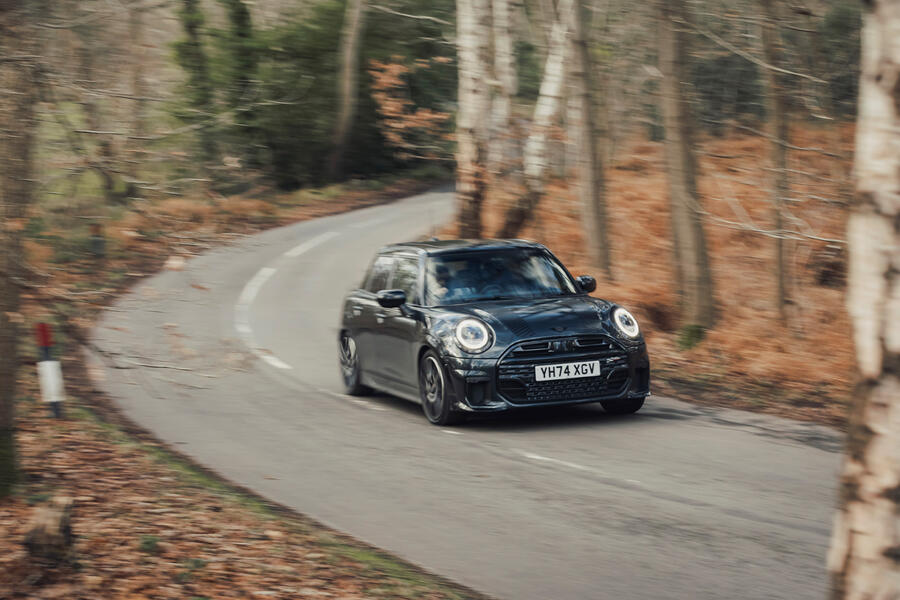
Usually, the prospect of schlepping from my south London pad to the West Midlands would have me frantically calculating the possibility of catching a train (or, better yet, some cataclysmic winter bug). And at this time of year, when I will leave under cover of darkness, encounter axle-shattering potholes and risk being sideswiped by sprayblinded motorway meanderers? Driving simply doesn’t get any less appealing.
But I’ve got a Mini Cooper S to play with, so I’ve spent the morning planning a nice, twisty route that runs parallel to the M25 and M40 and freeing up my diary so I can spend an extra hour on the road.
If the standard Cooper C that I’ve just swapped out of was engaging enough to incentivise spontaneous Sunday morning drives, this more potent model is looking likely to double my monthly outgoings in unnecessarily spent hydrocarbons.
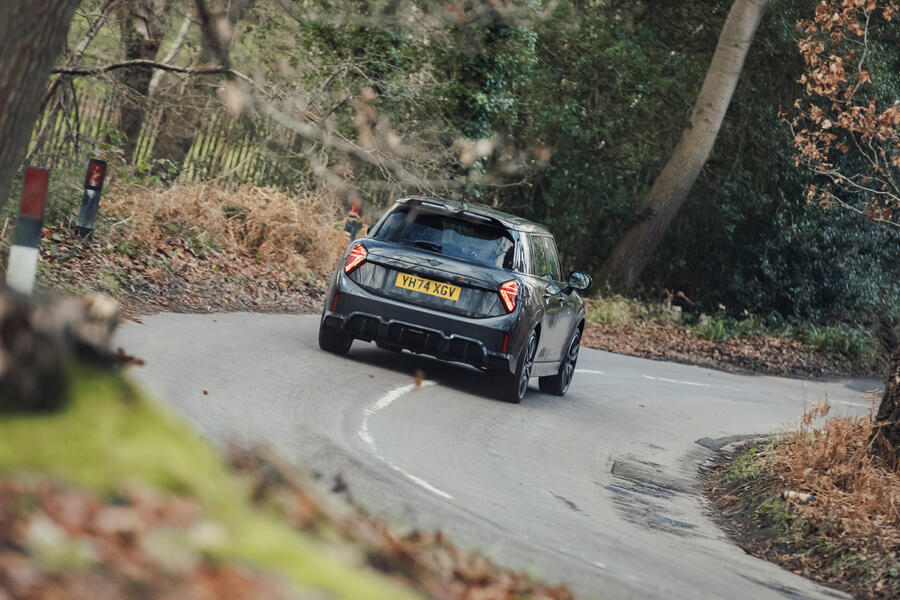
Already, even after just a couple of spirited blasts, it’s proving to be among the least compromised ‘fun cars’ I’ve daily-driven, which is to say it’s punchy and engaging without being unduly uncomfortable or catastrophically thirsty. It’s incentivising without being intimidating.
I will give a more nuanced account of its dynamic character once I’ve fully got under its skin, but suffice to say, for now, that the age-old formula of cramming 200bhp-plus of whooshing turbo grunt into the shell of a school-running, supermarket-bothering hatchback is one that holds enduring appeal.
I was pleased to discover that the differences between C and S are immediately obvious enough to sell this as far more than a gratuitous badging exercise. The range-topper looks mean, goes fast, steers sweetly and has all those angry red interior trimmings that you have to have in a performance car these days.
Arguably, though, beneath its heavily refreshed bodywork and dazzlingly digitised dashboard, this latest Cooper S is something of a dinosaur in 2025. Not in any real physical sense – the drivetrain still feels slick and the cabin doesn’t really want for any technical odds and sods – but conceptually.
With the likes of the Ford Fiesta ST and Hyundai i20 N consigned to the history books, the Cooper S has been le almost unsupported to stand and ght for the survival of the hot supermini.

The Ford Puma ST is too tall and the Toyota GR Yaris far too hardcore to bear comparison, so I make the Volkswagen Polo GTI the only real alternative on the market today – but that’s a comparative minnow in sales terms and is edging towards retirement.
Happily, green shoots of a genre renaissance are sprouting, thanks to EVs, with the Abarth 500e, Alpine A290 and Cooper SE suggesting that the appeal of a sporting supermini can survive the extinction of rorty little petrol engines.
Early details of the new Cupra Raval suggest it’s being developed with a keen eye on dynamic prowess, too, and stone-hearted are they who don’t feel at least a stir of anticipation at the promise of ‘gokart handling’ from Volkswagen’s first electric GTI car in 2026.
But these are fundamentally different beasts, which, despite the best efforts of their engineers, are inherently less mechanically charismatic and must be imbued with all manner of technical trickery to successfully emulate the emotive appeal of their forebears.
They don’t pop, fizz or grunt with the cheery loutishness of their forebears, and it’s far more difficult to set them aside from the humble family runarounds on which they are based.
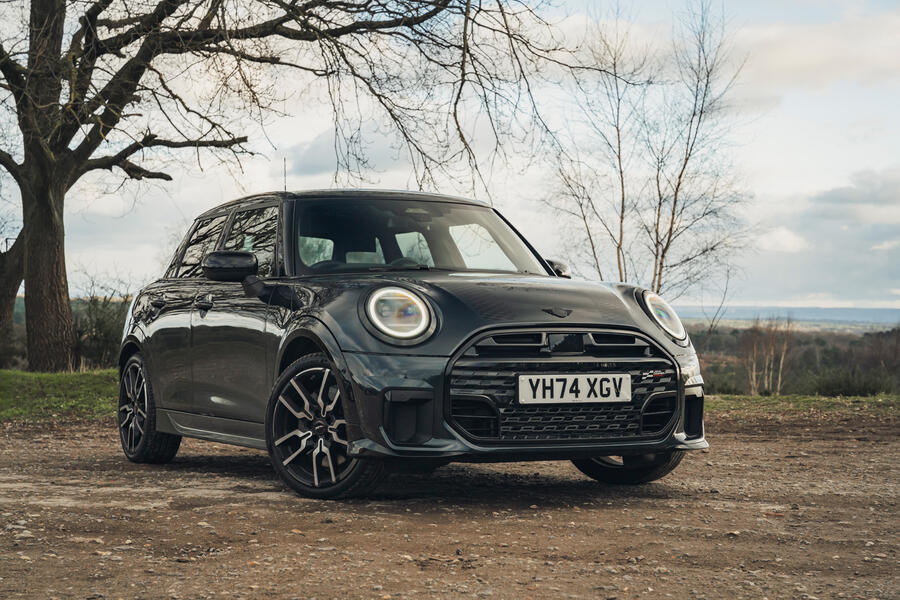
Say what you like about my Cooper S’s gratuitous John Cooper Works- avoured bodykit, racing stripes and fruity exhaust note, but there’s no mistaking it for a common-or-garden Cooper C.
And so I suppose I find myself writing something of a eulogy. The hot supermini is a type of car that has contributed more than its fair share of five-star road tests over the years, and of which you can trace the evolution back to such icons as the Peugeot 205 GTi and Renault 5 Turbo.
Even if a brave new electric era awaits (and accounting for the fact that the petrol Cooper S will be on sale until the end of this decade at least), there is undeniably an undercurrent of poignancy to my stewardship of this old stager, and I plan to celebrate every minute of it.
Beginning right now, with an urgent trip to the supermarket. Maybe one a few towns over.
Final update
It’s easy to become desensitised to the exorbitant prices of new cars as they creep, slowly but surely, ever upwards.
Just four years ago, the cheapest new car in the UK was £8000. Today, it’s approaching double that. So I’ll confess I didn’t immediately gulp, gasp or go berserk when I saw £34,500 at the bottom of the spec sheet for our Cooper S.
Given the general state of things, I thought it sufficiently equipped, suitably potent and aspirational enough to warrant price parity with, say, a speccy Audi A3 or a base-level Volkswagen Tiguan.
But after several thousand miles at the wheel, I’m running the numbers and wondering if I’ve been a bit short-changed, particularly when I had such a lovely time with the entry-level Cooper C, which is available for £10,000 less (albeit in our case with two fewer doors).
Sure, you get a healthy bump in power with the S, but rare was the occasion I found the C short on puff, and for the casual driver it’s still more than capable of raising a grin on a country lane.
Plus, the C’s more compliant suspension set-up and smaller wheels make it the more re ned proposition on our shattered roads.
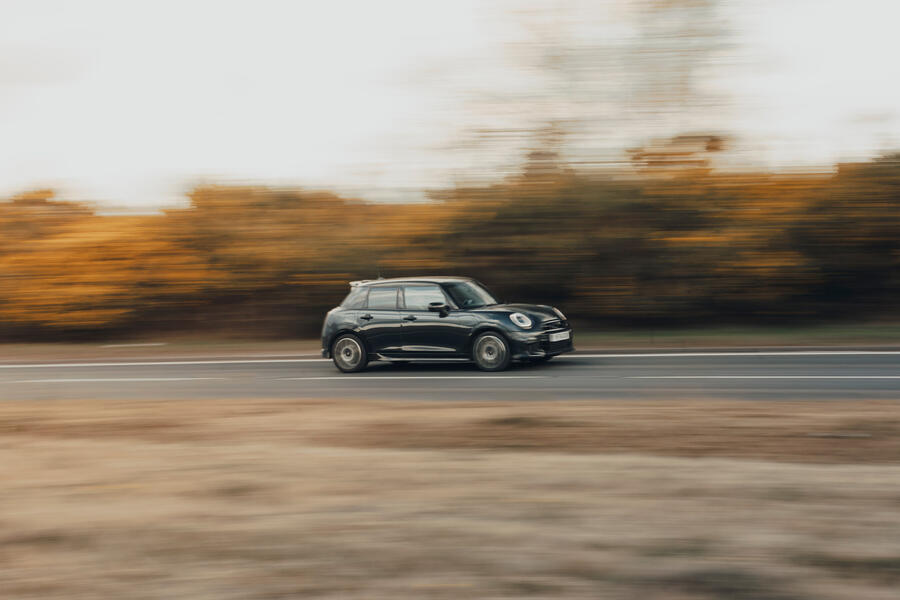
A compelling compromise. Some colleagues who drove both variants deemed the Cooper S the superior proposition purely on the basis that it’s equipped with paddle shifters and so offers a smidge of extra driver interaction over the auto-only 1.5-litre car.
But, honestly, after a few exploratory forays into manual mode, I found I’d had my fill of redlining the turbo four-pot and was broadly happy to let it meander through the ratios itself; the engine note isn’t especially avourful when you rev it out, and the plastic paddles themselves aren’t quite tactile and chunky enough to invite exuberance.
That’s not to say I didn’t have fun. The Cooper’s chassis tune is biased towards keen dynamics anyway, so the uprated brakes and firmer adaptive suspension that come with top-rung Sport trim mean it’s a riot on the right road, with a responsiveness and verve that incentivise you to push it to the limit, and a compact footprint that inspires confidence to let loose even on the tightest country lanes. Or multi-storey car parks, say.
The trade-off, naturally, is a secondary ride that’s persistently fidgety and often tends towards irritatingly harsh. I’ve certainly driven more brittle hot hatches, but stressful suburban commutes were made all the more aggravating by the S’s harsh treatment of speed bumps and potholes.
Happily, that’s about as uncompromising as the Cooper S gets and it falls into that sporting sweet spot of having enough power for a laugh, but not so much that you always have to have your wits about you.
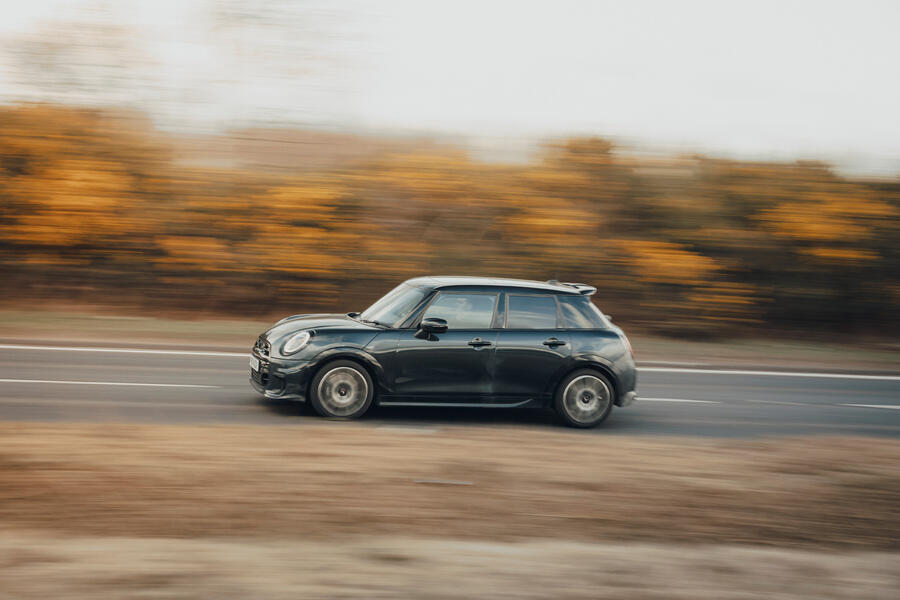
It’s an uncomfortable truth that the UK’s B-roads, by and large, are too poorly finished and confined to really facilitate full-blooded driving in everyday use, so being able to sprint from 0-62mph in just under seven seconds makes the Cooper S feel manageably exciting when the mood takes you – and it’s loud and low enough that it feels faster than that, in any case.
The extra punch doesn’t come at any dramatic cost to efficiency. Over the course of nearly 6000 miles, our 2.0-litre, five-door Cooper S proved barely any thirstier than the 1.5-litre, three-door Cooper C we ran before it, but it’s worth noting that a figure of around 40mpg is looking increasingly unimpressive – even in a quasisporting context – as other cars of this size adopt hybrid powertrains in a bid to clean up their act.
It’s a different kettle of fish, sure, but the MG 3 Hybrid we ran recently returned 47.0mpg, and we nudged towards the mid-50s in the Renault Clio Hybrid. With engines that date back to the launch of the previous generation Mini, and no assistance from a belt-integrated starter generator, no flavour of Cooper can come close: penny-pinchers need not apply.
It’s a mixed bag, then, but irrespective of all the pros and cons, the Cooper S is probably one of those cars you buy 60% with the heart and 40% the head – and given the dearth of direct comparisons to make, perhaps it compensates for its shortcomings by simply existing.
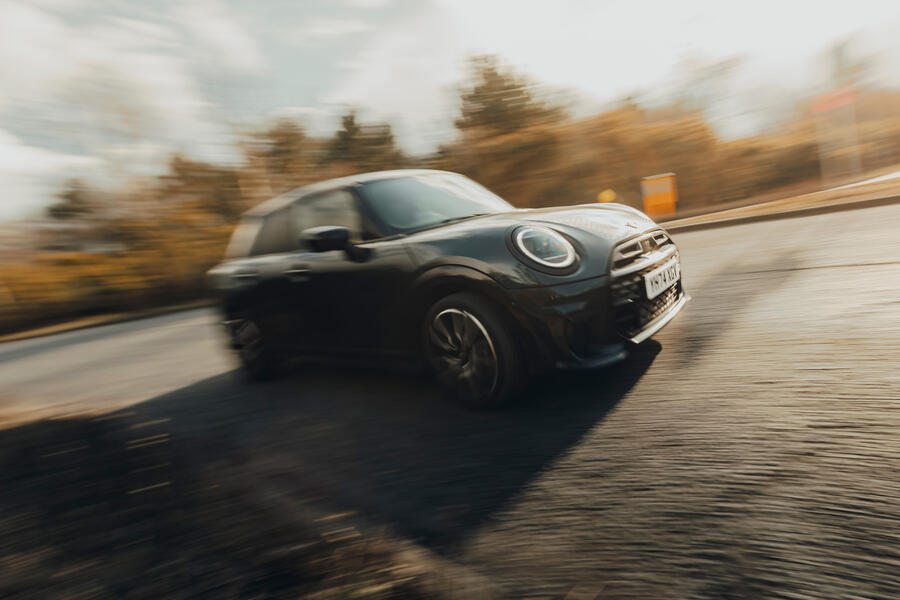
Intriguingly, my colleague Murray Scullion’s Mazda MX-5 long-term test car was a pretty close match in price and performance terms and, in light of the erosion of the affordable driver’s car market in recent years, could genuinely be considered a viable rival in its positioning as a circa-£35k thrill-seeker for daily use.
The Mazda is the vastly superior driver’s car, naturally, but then the Cooper S has back seats and a bigger boot so is more usable.
The roadster has a lovely, snickety six-speed manual gearbox too, which is an obvious one-up on the Mini – but the hatchback arguably has the edge in technology and refinement terms, which makes it the better long-distance companion… We could go on.
Ultimately, in a market that’s becoming increasingly shaped by profit-busting emissions legislation and fun-sponge safety rules, I think we can – indeed, we must – celebrate Mini’s commitment to the hot supermini.
While this latest model is a vastly more expensive and upmarket take on the formula than were its predecessors, it remains a relatively affordable gateway sports car in the context of what else is still in showrooms and it would be among my first recommendations for anyone looking for a comfortable, characterful and relatively capacious commuter car that’s capable of loosening its tie on a sunny Saturday afternoon
Mini Cooper S Sport 5dr specification
Prices: List price new £32,070 List price now £32,594 Price as tested £34,620
Options: Level 2 pack £2000, Legend Grey paint £550
Fuel consumption and range: Claimed economy 44.1mpg Fuel tank 44 litres Test average 40.1mpg Test best 42.8mpg Test worst 37.4mpg Real-world range 388 miles
Tech highlights: 0-62mph 6.8sec Top speed 150mph Engine 4 cyls in line, 1998cc, turbo, petrol Max power 201bhp at 5000-6500rpm Max torque 221lb ft at 1450-4500rpm Transmission 7-spd dual-clutch auto, FWD Boot capacity 275 litres Wheels 17in, alloy Tyres 215/45 R17 Kerb weight 1355kg
Service and running costs: Contract hire rate £475pcm CO2 145g/km Service costs None Other costs Two punctures, £330 Fuel costs £906.97 Running costs inc fuel £1236.97 Cost per mile 16 pence Faults None




Add your comment